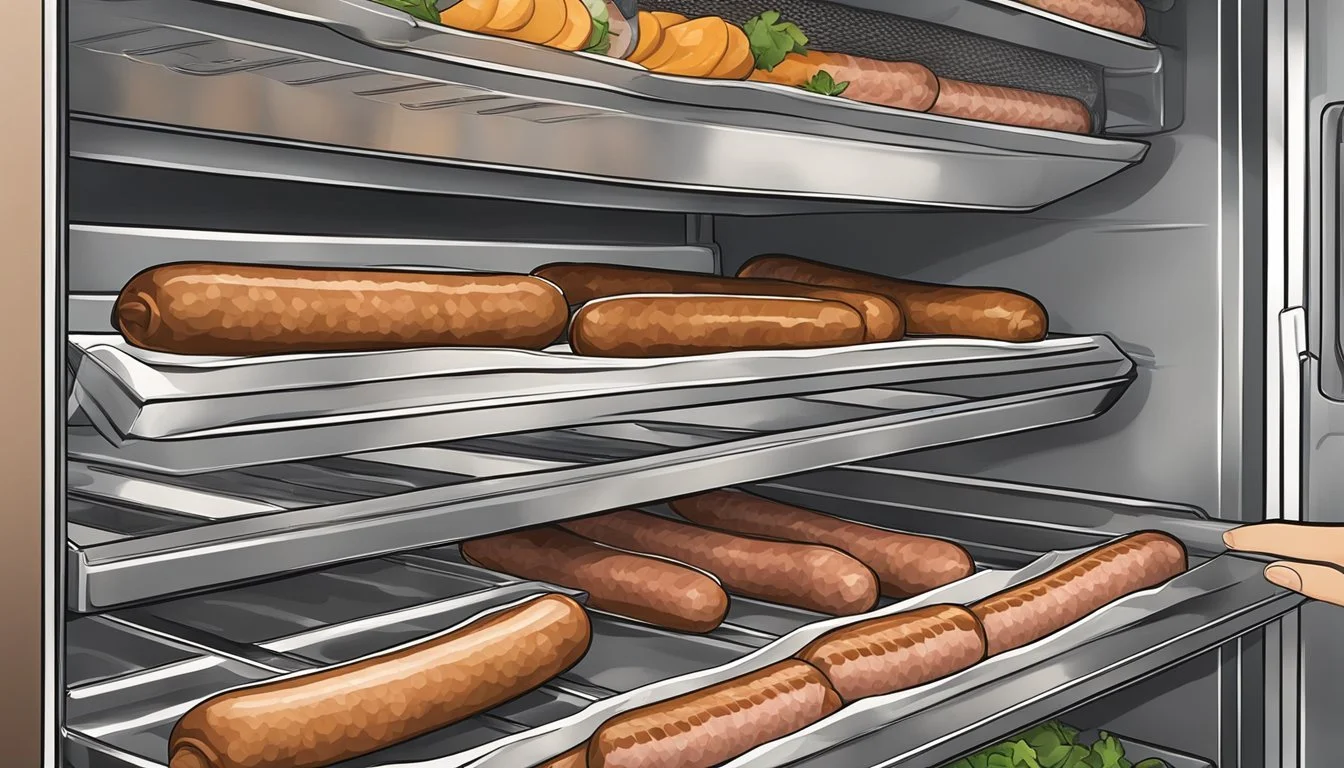How Long Do Sausages Last?
Uncovering Shelf Life and Storage Tips
Understanding the shelf life of sausages is important for both food safety and quality. Factors like the type of sausage, whether it's cooked or uncooked, and how it's stored, all play a role in determining how long sausages can last before they're no longer safe or optimal to eat. Generally, uncooked fresh sausages can be stored in the refrigerator for one to two days. Once cooked, sausages should be consumed within three to four days when kept in the refrigerator at 40 °F or less.
For sausages that have a longer shelf life, such as hard or dry sausages including pepperoni and Genoa salami, the storage times can be significantly extended when they are kept unopened. These types of sausages can be safe to consume for weeks or even months if stored properly. Once opened, however, it's recommended to consume them within a shorter timeframe, usually within three weeks. It's paramount to adhere to storage guidelines to ensure the sausages remain of good quality and safe to eat.
The storage environment should be carefully controlled, as sausages are perishable. In the freezer, sausages can maintain their best quality for about six months. Nevertheless, even in the freezer, sausages don't last indefinitely. It's crucial to monitor for signs of spoilage such as a sour smell, dull color, or slimy texture to prevent foodborne illness. When these signs are present, it's best to discard the sausages regardless of their storage time.
Types of Sausages
Sausages come in an assortment of types, each with unique preparation methods and flavor profiles. Characteristically, they can be categorized by their content and preparation:
Fresh Sausages: These include fresh pork sausage, breakfast sausage, and bratwurst. Fresh sausages are made from meats that have not been previously cured and must be refrigerated and cooked thoroughly before consumption.
Cooked Sausages: These are typically fully cooked or partially cooked during the manufacturing process. Products like pre-cooked breakfast sausages fall into this category and require reheating for serving.
Dry and Semi-Dry Sausages: Dry sausage and dried sausages like pepperoni and Genoa salami undergo a drying and fermentation process, concentrating the flavors. They can be smoked or unsmoked and are typically shelf-stable.
Raw Sausages: This includes raw pork sausage, chorizo, and other varieties that are sold raw and require proper cooking to an internal temperature recommended by food safety guidelines.
Sausage Type Characteristics Examples Fresh Sausage Not cured, needs cooking Pork sausage, bratwurst Cooked Sausage Fully or partially pre-cooked Pre-cooked breakfast sausage Dry/Semi-Dry Sausage Aged, may be smoked, shelf-stable Pepperoni, salami Raw Sausage Sold raw, must be thoroughly cooked Chorizo, raw pork sausage
Additionally, sausages vary in the kind of ground meat used, with pork being one of the most common. However, they can be made from beef, lamb, veal, poultry, or mixtures thereof. Each type of sausage provides a distinct texture and taste and has different storage and cooking requirements to ensure safety and quality.
Understanding Sausage Shelf Life
The shelf life of sausages varies depending on their type and storage conditions. Fresh sausages, such as breakfast links or bratwurst, should be consumed within one to two days when stored in the refrigerator. Once cooked, these sausages are best eaten within three to four days.
Hard or dry sausages, like pepperoni and Genoa salami, enjoy a longer shelf life due to their curing process. Unopened, these can last in the fridge for up to six weeks and, if kept in a pantry or storage area, they can be safe to eat for up to six months. Once opened, they should be consumed within three weeks.
Consumers should be mindful of three important dates on sausage packaging:
Sell-by date: This indicates the last day a product should be sold, after which its freshness cannot be guaranteed. However, sausages may still be safe to eat if stored correctly.
Use-by date: Products should be consumed by this date to ensure quality and safety.
Expiration date: Eating the sausage past this date is not recommended, as it could pose health risks.
It is imperative to store sausages at 40 °F or below to minimize bacterial growth. Here's a quick reference table for better clarity:
Type of Sausage Refrigerator (Uncooked) Refrigerator (Cooked) Freezer (Uncooked or Cooked) Fresh Sausages 1-2 days 3-4 days Up to 2 months Hard/Dry Sausages (Unopened) Up to 6 weeks - Up to 6 months Hard/Dry Sausages (Opened) Up to 3 weeks - -
Should one observe changes in color, smell, or texture, or if the use-by date has passed, it is safer to discard the sausage. It is essential to handle and store sausages properly to ensure they stay safe and delicious.
Storage Guidelines
Proper storage conditions are paramount for maintaining the quality and safety of sausages. The key to maximizing the shelf life of sausages depends on maintaining appropriate temperature control and using suitable packaging.
Raw Sausage Storage
Uncooked fresh sausage should be stored in the refrigerator at 40 °F (4 °C) or less and consumed within one to two days. If the package is unopened, one should adhere to the use-by date; however, even after the sell-by date expires, the sausage can be safe to eat if it has been properly stored. For longer storage, raw sausages can be frozen.
Cooked Sausage Storage
Cooked sausages are best kept in the refrigerator for three to four days. They should be stored in shallow airtight containers or wrapped tightly in plastic wrap or aluminum foil to preserve quality and prevent contamination. Cooked sausages can also be frozen for extended shelf life.
Freezing Sausages
Freezing sausages, both raw and cooked, is an effective preservation method. Sausages should be stored in the freezer at 0°F (-18°C). For optimal protection against freezer burn, they should be wrapped in heavy-duty plastic wrap, aluminum foil, or placed in airtight containers or vacuum-sealed. Properly packaged, cooked sausages can be kept in the freezer for two to three months, while raw sausages will maintain their quality for up to two months.
Refrigerating Sausages
Refrigeration is crucial for both raw and cooked sausages to prevent spoilage and foodborne illness. For refrigeration, sausages should be kept in their original packaging until ready to use; once opened, they should be transferred to a sealed container or re-wrapped to maintain freshness. It's important to ensure that the refrigerator temperature stays at 40 °F (4 °C) or below for safe storage.
Signs of Spoilage
When assessing whether sausage has gone bad, one must be attentive to certain spoilage indicators. Spoiled meat poses a health risk due to the growth of bacteria, which can cause foodborne illness.
Visual Inspection
Color is a reliable initial cue when inspecting sausage. Fresh sausage typically has a vibrant pink or red hue. Discoloration such as turning grey, brown, or greenish is a strong sign of spoilage. Also, be on the lookout for any signs of mold—these can manifest as fuzzy, green, or white spots.
Texture and Touch
The feel of the sausage is also telling. Fresh sausage should have a firm texture. If the surface feels slimy or sticky, this could be indicative of bacterial growth, and the sausage should not be consumed.
Smell Test
Lastly, smelling the sausage can be a definitive method to check for spoilage. Fresh sausage may have a mild meaty smell combined with the aroma of any incorporated herbs or seasonings. A rancid or off-putting odor is a clear indicator that the sausage has spoiled and should be discarded.
Food Safety Considerations
When discussing the shelf life of sausages, food safety is paramount. Sausages, as a protein-rich food, are highly perishable and can foster bacterial growth if not handled properly. The temperatures sausages are stored at are critical; to remain safe to consume, they must be kept refrigerated or frozen.
Storage Guidelines:
Uncooked sausages with beef, pork, lamb, or veal: refrigerate for 1 to 2 days.
Uncooked poultry sausages: refrigerate for 1 to 2 days.
Cooked sausages: they can be safely stored in the refrigerator for 3 to 4 days.
For uncooked sausages, one must ensure:
They are cooked to a minimum internal temperature of 160°F for those containing beef, pork, lamb, or veal.
For those containing ground turkey or chicken, the temperature must reach 165°F.
List of Don’ts:
Don't leave sausages at room temperature for more than 2 hours.
Don't consume sausages if they have an off smell, color, or texture.
Don't refreeze sausages that have been thawed.
Consuming improperly stored or cooked sausages can lead to food poisoning. Symptoms may include stomach cramps, nausea, fever, vomiting, and diarrhea. If someone experiences severe, persistent, or worrisome symptoms, they should seek medical attention. Proper storage and cooking are critical in preventing illness and ensuring sausages are enjoyable and safe to eat.
Proper Handling and Preparation
Ensuring food safety with sausages begins with proper handling and preparation. Attention to temperature during defrosting and thorough cooking are crucial to maintaining both the quality and safety of the meat.
Defrosting and Thawing
When thawing frozen sausages, it's important to avoid leaving them at room temperature, as this can lead to bacterial growth. Instead, they should be thawed in the refrigerator to maintain a safe temperature. For quicker thawing, one can use the microwave on the defrost setting or submerge the sausages in cold water, changing the water every 30 minutes until they are fully thawed.
Cooking and Reheating
Uncooked sausages made from ground beef, pork, lamb, or veal should be cooked to an internal temperature of 160°F, whereas sausages containing ground turkey or chicken need to reach 165°F. When reheating, sausages should be brought up to the same temperature to ensure they are safe for consumption. Bulk preparations or those with higher fat contents may require longer cooking times to reach these temperatures evenly throughout. Seasonings or additives typically don't affect the required internal temperature but can enhance flavor if sausages are cooked properly.
Frequently Asked Questions
How long can I store packaged sausage in the refrigerator?
Fresh, uncooked sausages can be refrigerated for one to two days. Once cooked, they should be consumed within three to four days.
What is the shelf life of sausage in the freezer?
Packaged sausage can be frozen for up to two months. They retain better taste and texture if used within the first month.
How do I know if leftover sausages have gone bad?
Leftover sausages may have gone bad if they exhibit any changes in color, smell or texture. Discard any sausage that seems suspect.
Can I eat sausage past the sell-by date?
Sausage should not be consumed past the sell-by date as the safety cannot be guaranteed. It's important to adhere to storage guidelines and use or freeze sausage before this date.
What's the best way to store sausage to extend its shelf life?
Keeping sausages in an airtight container or wrap in the refrigerator or freezer can help extend its shelf life. For the best quality:
Refrigerator: Keep at 40°F or less.
Freezer: Store in airtight packaging to prevent freezer burn and maintain quality.






